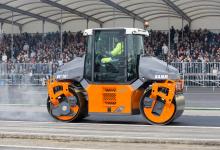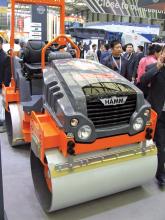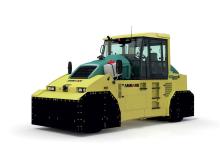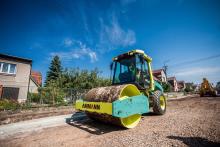New compaction models and a brand new factory are strong examples of how the
Reinhold Baisch is sales manager at Hamm and said, “We have invested heavily in research and development.” He added that the firm is keen to retain its strong position in the sector and said, “We are one of the biggest suppliers of compaction technology.”
The production facilities at the Hamm compactor plant, two hours’ drive to the north of Munich in Bavaria, have benefited from an investment of more than €20 million. This has been spent on the latest manufacturing processes and equipment, as well as major improvements to the plant and buildings. Located at Tirschenreuth, the factory can now build up to 15,000 compactors/year and sits on a 353,000m2 plot of land, with the office and factory buildings covering some 43,000m2 and employing 750 people.
A flexible manufacturing system allows the firm to make the drums for its machines in small batches to meet needs for special requirements. The roller presses bending material for the drums can handle steel plate up to 45mm thick by 2.3m wide, with this rolling process taking up to 45 minutes for some of the larger drums. In all, the firm makes up to 60 different types of roller drums. For the padfoot rollers, the pads are tack welded on using a former and then fixed in place. Meanwhile asphalt drums are machined using a lathe, a process that can take from 30 minutes to six hours depending on their size. CNC milling and boring of the drums is carried out to ensure these meet high tolerance requirements. In all it can take from 7-30 hours to construct a drum completely, depending on its size and the features required, with the padfoot oscillatory drums being the most complex.
The lean manufacturing system means that the plant can produce different models on the same line, each built to specific order and featuring the required specifications and components for the local market. The firm is able to install Tier 2, Tier 3, Tier 4 Interim and Tier 4 Final engines as required by the local market needs. While there are 56 basic models in the range, the number of permutations available means that there are thousands of variants possible. In effect, the versatile assembly line can produce models in single unit batches. Around 180-200 rollers/month are built at the plant at the moment, with the operation running on a two shift basis. Meanwhile all of the 100 employees who work on the production line are trained to be able to carry out any of the tasks.
Quality checks are carried out throughout the manufacturing operation and this testing facility has been upgraded to cope with the increased throughput of the plant. Once a machine reaches the end of the production line, it undergoes a comprehensive testing process that lasts from 90-180 minutes, to ensure this quality is optimised. The capacity of the final inspection area was doubled and the new generation of low emission engines for sale in Europe and North America mean that the team have to pay particular attention to those models featuring the latest complex exhaust after-treatment systems. The test rig is said to be state-of-the-art as well as being more efficient. All steps in the testing process are linked with a new SAP module, which features detailed test schedules and error messages for every machine. This simplifies the testing process and allows for more accurate and speedy fault analysis, while optimising quality management.
Prototype endurance evaluation is now carried out in a special long-term test area. This allows engineers to operate rollers and systems with new ancillary and special equipment in hilly terrain under remote control, without the need for a driver. With this setup, machines can provide crucial measurement data over long periods of operating hours, while the engineers simulate different loads.
For the soil compaction market, Hamm now offers the new H5i and H7i single drum models and Baisch said, “We’ve introduced new design elements from the larger machines in to the five and seven tonne class soil compactors.”
The new rollers will be available from early 2015 and compete in the 4.5tonne to 8tonne class. Both models feature compact designs, while also being easy to operate and offering good gradeability for use on challenging terrain. Baisch said that these models are not just smaller versions of the proven H series, but have been designed from the start as compact soil compactors. A key feature is with the traction drive as the wheels are driven by wheel motors rather than via a rear axle. This is said to boost climbing capacity and allow better ground clearance than on earlier models.
The driveline design has also helped keep the machines short and the H7i measures just 4.4m long, making it the most compact machine in its weight class according to the firm. Combined with the three-point swivel joint and a short wheelbase, this compact configuration is said to ensure good driving and handling characteristics, allowing it to be operated more easily on confined construction sites where working space is restricted.
The new control panel is based on the proven design used in the firm’s successful HD CompactLine, with the layout of the steering wheel allowing an unobstructed view of the high visibility display. All round visibility for the driver is also said to be good, boosting safety and ease of operation.
Both models are powered by 55kW diesels that meet Tier 4 Final/Stage IV emissions requirements. Another important feature is a system that shuts off the engine if the machine has been at rest for an extended period, saving fuel. The versatile manufacturing system Hamm has installed in the factory also means that customers can specify special features such as electronic data transmission interfaces, electronic battery isolating switches or power-saving LED lighting technology.
The drums are available in smooth and padfoot configurations and the latter option includes the newly designed two-part padfoot segments. A dozer blade is optional for both models while the 7tonne machine can also be specified with a VIO drum, capable of compacting with either vibration or oscillation.
For the asphalt compaction market meanwhile, the DV+ 70i and DV+ 90i tandem rollers are said to be highly productive machines offering good visibility and easy operation. Baisch said that these 7tonne and 79tonne class asphalt compactors are highly versatile and have been designed so that they can be operated in either direction. To ensure a range of options for the customer, the machines are being offered in three variants: as a double vibratory roller (VV), an oscillatory roller (VO = a vibratory and oscillatory drum) and as a combination roller (VT).
The large cab has been designed to allow the driver to see the drum edges and edge pressing device, aided by an innovative water tank configuration. The spacious cab is said to be easy to access and offers a wide range of adjustment options, while the seat in the DV+ can be rotated by 180° in either direction, allowing a driver to face in the direction of travel for all operations.
Both models are driven by the latest low emission engines, with a 75kW diesel in the DV+ 90i said to better the requirements for Tier 4 Interim/Stage IIIB legislation. Meanwhile the 56kW diesel in the DV+ 70i meets the Tier 4 Final/Stage IV requirements. Both models have diesel particulate filter (DPF) systems to remove soot particles, which also allows them to meet the tougher emissions requirements of markets such as Switzerland.
The mid-mounted engine and two-part water tank is said to optimise weight distribution, while the split drums and pivot steering allow manoeuvrability and versatility for high quality compaction even on tight corners. An automatic reverse transmission with graduated braking and acceleration helps optimise reversing, ensuring compaction is carried out without leaving bumps or hollows on the surface.








